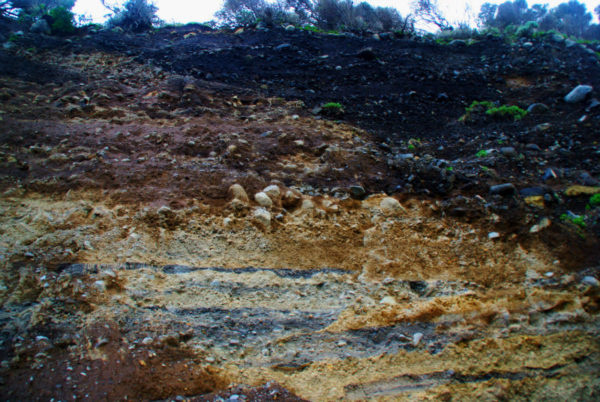Halfway between Acireale and Taormina, in the municipal area of ??Giarre, there is a very special beach: Praiola. The beach is very small and narrow, even uncomfortable, as it is formed by large round stones and in continuous movement due to the frequent sea storms. But people love to bathe here, despite the difficulties, and maybe they don’t even know they are in a place that geologically tells the story of Mt. Etna.
A few meters from the beach, in fact, there is a huge “cliff” that plunges directly into the sea. They call it the “Chiancone”. Today it has been colonized by the holiday cottages of the tourists but its overhang, almost inaccessible and still wild, is a true geographical map of different and very important parts of soil. It is very useful to understand what was there before Etna and how the territory has changed.
The landslide that created the Chiancone
 Seen from below, the Chiancone of Praiola is just another portion of steep coast among the many that are in Sicily. But if you look at it from above you would see that it is the final part of a giant landslide that starts from Etna and reaches the Ionian Sea. It is, in fact, the landslide that occurred about 8000 years ago when a whole side of the then volcanic complex collapsed on itself, crumbling towards the valley.
Seen from below, the Chiancone of Praiola is just another portion of steep coast among the many that are in Sicily. But if you look at it from above you would see that it is the final part of a giant landslide that starts from Etna and reaches the Ionian Sea. It is, in fact, the landslide that occurred about 8000 years ago when a whole side of the then volcanic complex collapsed on itself, crumbling towards the valley.
The landslide brought to the sea a quantity of waste so impressive as to generate a wave of tsunami that destroyed the coasts of Greece and Africa in a few hours. Slowly in time, the sea has eroded a good part of those materials – from which the beach of Praiola was born – and what still remains is a real geological “book”.
Why is the Chiancone so important?
About 30 meters high, the Chiancone covers about 40 square kilometers . Today, towns, cities, campsites and more have been built on it. Its importance, on the other hand, has only recently been discovered, after specific studies conducted by geologists. Because the Chiancone is like a guide, a manual, a map that helps us “read” the changes in the soil of this corner of Sicily over the millennia.
The various layers of rocks and soil appear mixed, intertwined, the result of the rapid progress of the landslide after the collapsing of Etna. But the expert eyes can still recognize the individual elements very well. Layers of alluvial mud merge with the remains of very ancient lava material, which testifies to the difference between the volcano as it was thousands of years ago and that of now.
How to visit the Chiancone of Praiola
To visit the Chiancone of Praiola you must take the A18 highway – from Catania or Messina – exit at Giarre. From here, you will follow the Provincial Road 2 towards Riposto and then the nr.9 following the signs for Praiola. The road that descends to Praiola ends right in front of the stony beach. Here you will have to walk a few meters south to find yourself under the Chiancone.
Another way to admire the expanse of the Chiancone, although not its cliff with the geological strata, is walking in the Contrada Gancia, in Giarre. From up here you have a perfect view of all the surface occupied by this residue of millennial landslide. Otherwise, renting a boat in Riposto or Giardini, you can admire it from the sea to realize the immense historical and geological potential of this beautiful cliff. (photo by Grazia Musumeci)